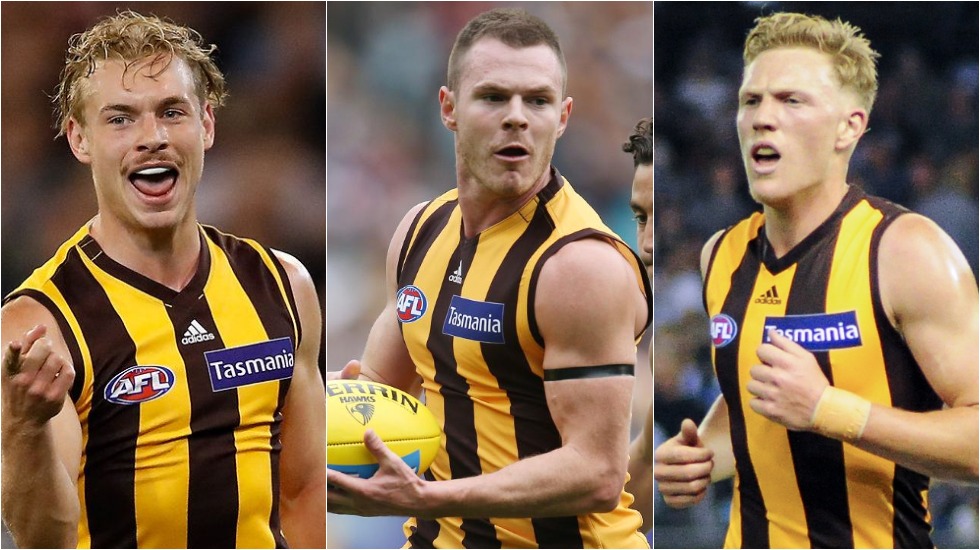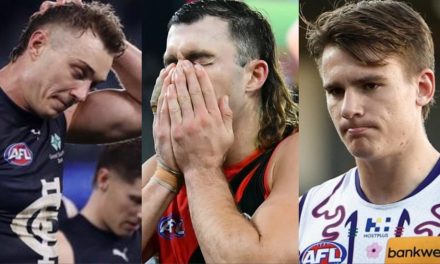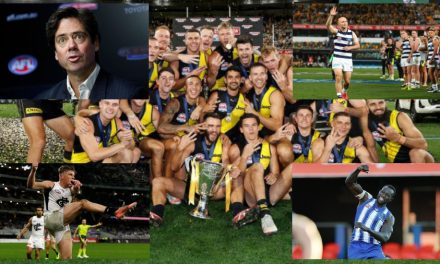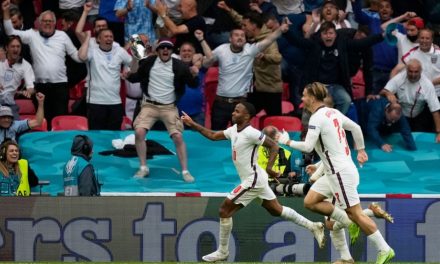From left, James Worpel, Blake Hardwick and James Sicily, three young Hawks going places. But beyond that?
One of the most fascinating struggles of the modern era of AFL football is that between clubs and the competition’s equalisation measures.
For well over 30 years now, the salary cap and the draft have been the ultimate handicapper, giving the downtrodden an extra push forward and placing extra weight in the frontrunners’ saddle bags.
The goal is not only to give every team at least some chance of success, but to make it harder for the perennially successful to sustain it. Some fight that tide much better than others, but at some stage the struggle catches up with them, too. And right now, that’s how it’s looking for Hawthorn.
The superficial view of the Hawks’ current malaise is focussing on the tenure of coach Alastair Clarkson, or their game style. But I think the reality is bigger picture, and not even about deficiencies or failure in this or that area, but more the inevitability of equalisation getting you in the end.
It’s been an interesting five years for Hawthorn since the third leg of its premiership hat-trick in 2015. They’ve been up, down, up, down, and up and now down again in less than five completed seasons.
Good enough to finish the premiership season in the top four in 2016 before going out of the finals in straight sets (both narrow losses), they then lost five of their first six games the following year and missed out on September.
But recovery was swift, and in 2018 they went into another finals campaign with a top four berth, again losing both finals. They struggled through much of last year, but hit form towards the end, winning six of their last eight. Thus, with the imminent return of injured Brownlow medallist Tom Mitchell, there was plenty of optimism about 2020.
What seems a little clearer now, however, is that those mini-revivals might have got in the way of progress. And there’s a fair argument it’s really not even through anything Hawthorn or Clarkson have done wrong.
This is a club which was ahead of the curve when it came to doing everything possible to stave off a downturn.
The Hawks set the pace a decade ago in terms of hand-picking experienced players from other clubs to supplement what they acquired at the draft table. And the likes of Shaun Burgoyne, Josh Gibson, Ben McEvoy, David Hale, Brian Lake and James Frawley all played key roles in that flag trifecta between 2013-15.
They then bit the bullet harder than has any rival of the modern era in drawing a line through the Hawthorn careers of even certified club champions like Sam Mitchell, Jordan Lewis and Luke Hodge in order to keep an eye on the future as well as on the present.
How many other clubs would have had the courage to do that with players of that stature when all believed they had (and subsequently underlined elsewhere) that they still had AFL games left in them?
But it’s also been the consistent success and durability of those imports which has impacted on the acquiring and development of the younger generation. And that’s been felt painfully over the last three losses, during which Hawthorn has won just one quarter of football.
Across the 2020 season to date, the Hawks have fielded the second-oldest senior 22 of any side. Last Sunday’s line-up against Melbourne contained no fewer than half-a-dozen players at least in their 32nd year. But so durable and valuable have so many of their veterans remained that they’ve had little choice but to keep playing them.
Until recently, their performances have remained solid. Last year was the first time since the flag hat-trick that at least two players among the top five in Hawthorn’s best and fairest hadn’t played in any of those grand final wins.
Yet, even in 2019, the likes of Liam Shiels, McEvoy, Luke Breust and Ben Stratton were still good enough to at least finish in the top 10. What individual declines there have been have tended to be gradual, and often complicated (like the case of Breust last year) by a temporary upturn.
That has consequently limited the opportunities of the youngsters on the list. Which has meant it’s taking Hawthorn longer than some of their less-successful rivals to establish whether some players can cut it or not in AFL company.
We know with certainty James Sicily can. Ditto Blake Hardwick. And whilst not as impressive this season as in his best-and-fairest winning 2019, you’d have to add James Worpel to that list. But beyond that?
There are nine players on Hawthorn’s list (including rookies) still to play a single senior game, and a total of 14 who have played only seven games or less. There are another seven who have played only between 10 and 20. That group includes Conor Glass and James Cousins, who both debuted four seasons ago, and Conor Nash, who debuted in 2018.
These days, that’s a fair amount of time for the jury on a player to still be out. But it’s been hard for the Hawks to make confident decisions on any of them either way when the amount not only of exposed form, but responsibility they’ve had to take once they do play, is relatively minor.
And that means that when the contribution of the senior hands diminishes seemingly at once, there simply aren’t enough alternative hands steering the ship. Hence the recent hesitation and lack of confidence which has been apparent in Hawthorn’s conservative ball movement.
Sure, the Hawks face some more tough decisions on veterans who aren’t performing. But even then it’s going to take at least some time before they know for sure whether the potential replacements can fit the bill.
Such is the dilemma AFL clubs face in staving off the inevitable drag of the system. Carlton and Melbourne learned through bitter experience that complete clean-outs can leave a list and a club horribly exposed.
Yet even those who manage to transition less dramatically whilst remaining competitive come to the crossroads sooner or later, their success in carrying out a “holding mission” only complicating the process further down the track.
And no matter how magnificently they’ve defied the evolutionary process for so long, that may be where the Hawks also now find themselves.
This article first appeared at ESPN.











